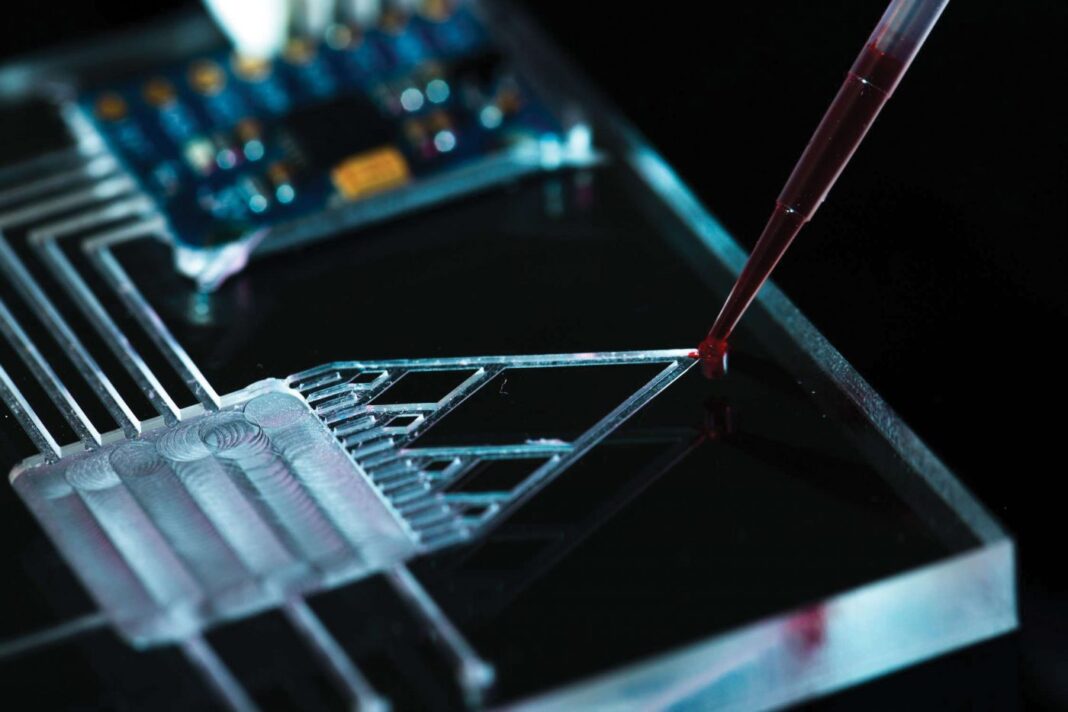Devices with intricate interlacing channels, the width of a human hair, that move minuscule amounts of liquids, and can be used to diagnose and treat complex diseases, can now be made using a cost-effective, quick, and reliable method.
A recent study by a team of scientists at the University of Bristol describes a method for the rapid development of complex microfluidic devices made of polymers using 3D-printed interconnecting microchannel scaffolds and open-source resources developed by the team.
This breakthrough technology is reported in the PlosOne article titled, “Negligible-cost microfluidic device fabrication using 3D-printed interconnecting channel scaffolds.”
Popularly called bedside testing, remote testing, mobile testing, or rapid diagnostics, clinical testing that can be performed at the site of patient care rather than in a laboratory, is the essence of point-of-care (POC) testing. POC testing tools are made possible through lab-on-a-chip (LOC) technologies that have gained wide popularity over the last few decades as the answer to biological, chemical, and global-healthcare challenges.
This new technology has the potential to hasten the development and implementation of LOC diagnostic techniques in underdeveloped parts of the world where rapid diagnoses are desperately needed to improve public health, mortality, and morbidity.
Microfluidic devices underpin LOC technologies to make POC testing possible for the swift and effective detection and treatment of many diseases.
Building a microfluidic device is labor-intensive. Reducing the time and effort it takes to produce these devices is therefore of paramount research interest. Currently, technologies used to develop microfluidic devices include lamination, injection molding, and soft lithography.
Various polymers are used to build microfluidic devices, selected based on their biochemical performance, cost, fabrication attributes, specific applications, temperature resistance, and biocompatibility. The authors in the current study used a polymer called polydimethylsiloxane (PDMS) in their fabrication protocol.
The authors developed an alternative for producing the soft-lithographic molds, making the fabrication of microfluidic devices accessible and affordable.
“Previously, techniques for producing the soft-lithographic scaffolds/molds (microfluidic channel patterns) were time-consuming and extremely expensive, while other low-cost alternatives were prone to unfavorable properties. This development could put LOC prototyping into the hands of researchers and clinicians who know the challenges best, in particular those in resource-limited settings, where rapid diagnostics may often have the greatest impact,” said Robert Hughes, PhD, lead author of the study and lecturer in the mechanical engineering department at the University of Bristol.
“This technique is so simple, quick, and cheap that devices can be fabricated using only everyday domestic or educational appliances and at a negligible cost (~0.05% of cost of materials for a single microfluidic device). This means researchers and clinicians could use our technique and resources to help fabricate rapid medical diagnostic tools quickly and cheaply, with minimal additional expertise or resources required,” said Harry Felton, co-author on the study and PhD student at the University of Bristol.
“The simplicity and minimal cost of this technique, as well as the playful click-and-connect approach developed, also makes it suitable for hobbyists and educational use, to teach about microfluidics and the applications of lab-on-a-chip technology,” said Andrea Diaz Gaxiola, co-author on the study and PhD student at the University of Bristol.
These scaffolds are designed with interconnecting ends and used to quickly configure complex patterns of microchannels and embedded in PDMS to produce an imprint of the pattern.
The scaffolds are printed using common Material Extrusion (MEX) 3D printers which limits cost. The authors showed that with off-the-shelf printer modifications, channel cross-sections as tiny as a hundred square microns can be made.
Customized microfluidic systems can be built without any specialist equipment using the protocol reported in the paper for fabrication of microfluidic channel molds from thermoplastic 3D-printed scaffolds.
The architecture of the PDMS microchannels fabricated using the protocols can be evaluated and applied directly to glass without plasma surface treatment. The authors showed that the microfluid device operates within the typical working pressures of commercial microfluidic devices.
The study validates the technique by demonstrating the fabrication of two common microfluidic devices: a fluid-mixer demonstrating effective interconnecting scaffold design, and a microsphere droplet generator.
“It is our hope that this will democratize microfluidics and lab-on-a-chip technology, help to advance the development of point-of-care diagnostics, and inspire the next generation of researchers and clinicians in the field,” said Hughes.
The team is now trying to identify potential collaborators in both research and education to demonstrate the impact this technology could have in both settings by developing and supporting outreach activities and applications for on-chip diagnostic testing.



